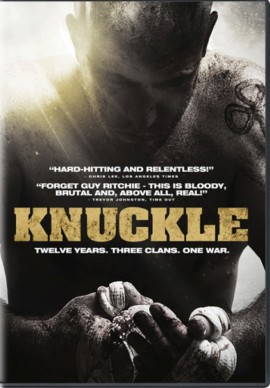‘Knuckle’ follows a group of violent Irish Travellers

All those boxers, wrestlers and UFC guys can sit down, shut up and say “Hello” to the men of the Irish Travellers community. These ridiculously childish fighters are the real deal, solving their problems with no-holds-barred “fair fights” on isolated country roads in Ireland and England.
Consider yourself warned.
The Travellers, clans of nomadic husbands, wives and children, covet their family name. So much so that when a competing family issues a challenge to fight, a man from each community is selected and a street brawl ensues. These fights feature no gloves, no padding, no bells or times for respite. Two men, bare knuckles and a couple of spectators — that’s it. Who will be the last man standing?
This almost tribal fighting is captured by the ambitious new documentary, Knuckle, from director Ian Palmer, who followed the Irish clans for 12 years. His footage is sometimes difficult to stomach, featuring punch after bloody punch. Forget about those YouTube videos showing backyard uppercuts and wannabe sucker punches. Palmer captures organized street fights that are so brutal it’s a mystery how these muscled men aren’t carted off by the police on a weekly basis.
Rather than just displaying the sick spectacle of blood, the 97-minute film tries to go deeper and find out why these men feel so compelled to defend their family’s name. We follow James Quinn McDonagh and Paddy “The Lurcher” Joyce, two men who seem to care about the people of their community, but when it comes to external relations, they break down, tape up those knuckles and throw peace out the door.
The film never quite digs deep enough to figure out why these men are so volatile. There’s talk of an incident in the early 1990s that left one person dead, but something darker is seeping through these veins. It’s not simply a question of some past crime or lapse in judgement.
It’s probably that some of these men, many of whom are related to their sworn enemies, have never graduated beyond the playground. They may live in houses now, but they should really be called clubhouses, because these men act more like gang members than functioning members of society.
It’s a shame that Palmer doesn’t elicit many answers. He seems to have grown too close to the community, and thus unable to offer an unbiased eye. Still, there’s no denying this footage is visceral and exclusive. What he films with his camera is essentially illegal activity, and turning a spotlight on these brawls will hopefully begin the healing process so one day they will end for good.
Because Palmer’s camera follows the McDonaghs and Joyces for so long, the documentary is able to depict the younger generation and how they are sucked into the violent world of their parents. Young boys look up to their fathers with wide eyes, waiting for the day when they too can head out and fight against people for no apparent reason.
Palmer’s camera is so dedicated that we even view a match by two guys and then watch their rematch a few years later. Tellingly, at the end of the fight, the bloodied men disagree on why they’re punching each other in the first place.
The actual fight scenes, which are graphic and somewhat gratuitous, will test the patience of the audience. James Quinn McDonagh, who is featured in a couple of fights, knows how to throw a punch and wreck the face of his opponents. The camera never looks away. We are right there with the boxers until the referees call the fight.
Because of the bottled-up emotion during each contest, only the fighters are allowed to be present, plus a few judges and unconnected spectators. The rest of the family members need to stay home, waiting to hear of the results. If a man walks away victorious, it usually means partying, alcohol and even hoisting the champion on the shoulders of his family members. If a man comes home in defeat, the excuses usually materialize and the planning for the next fight begins.
At one point, Palmer lets us know his thoughts on the violent challenges. One particularly bloody fight in the middle of the woods features two overweight grandfathers. Palmer, smartly, uses a voiceover to tell us that this is the last time he’s willing to film a fight. It’s just become too pathetic.
Although he ultimately breaks that promise, it was encouraging to hear his disdain for the subject matter he followed for more than a decade. With such unrelenting violence, there needs to be some subtext and words of caution. If the film didn’t try to get at the underlying issues of the rivalries, then there would be no point to the spectacle. But because Palmer is interested in documenting these Travellers at home, working, drinking, caring for children and, yes, fighting, Knuckle becomes a semi-important look at how society breeds violence and how parents unknowingly pass horrible traits to their children.
The filmmaker doesn’t answer all of his questions by the documentary’s end. And after watching so many young men walk away with bruised and bloody faces, it’s hard to see the value of all this footage. But it does achieve its goal: All this fighting doesn’t entertain one bit. It’s disgusting. It’s needless. It’s wrong. And it’s a testament to Palmer that he confirms these facts, rather than glorifies the brutality.
By John Soltes / Publisher / John@HollywoodSoapbox.com
-
Knuckle
-
2011
-
Directed by Ian Palmer
-
Running time: 97 minutes
-
Rated R for violent content and language
-
Rating:





